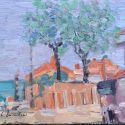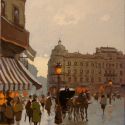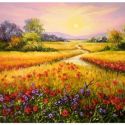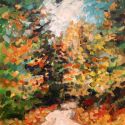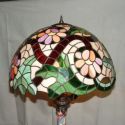Iasi is not only one of the best known and important Romanian cities, but also one where you will find many things and places to see, most of them with their own, rich stories, that weave an intricate history of the whole city. It is a pity not to come here and visit at least a few of the batch of sights, buildings, monuments, for you would only lose an opportunity to enjoy the riches of Iasi.
Culture Palace (Palatul Culturii) : it was officially opened in 1926, in the presence of King Ferdinand (who would die one year later). The project of the building was signed by the architect I.D. Berindei and it took almost took decades for workers to build the impressive house. It was placed on the ruind of the ancient king's court from 1430's, much later rebuilt in a Neo-Classical style by prince Alexandru Moruzi, in 1806 - 1812. The style of today's palace mixes various influences with the Neo-Gothic manner, resulting in a richly ornamented and complicated style, not to be ignored.
Those who come here must surely visit the Gothic Hall, where they can admire the large mosaic, depicting images from a Medieval bestiary, with images of lions, griphins and strange, mythical beasts. Also of interest is the Kings Hall, where you can see portraits of the rulers of Moldavia and the kings of Romania. You could also visit the "Henry Coanda" Hall, on the first floor, decorated according to the inventor's plans. Today, in the Culture Palace you cand find several museums : the Museum of History of Moldavia, the Ethnographic Museum of Moldavia, the Art Museum, the Stefan Procopiu Science and Technics Museum.
The Metropolitan Church and Moldavia and Bucovine : the idea of building a large, monumental church in Iasi originated in the 19th century, a dear project to Venianim Costachi, who was then the bishop of the church. Today's Metropolitan Cathedral was built in 1833 - 1839, after the plans of foreign architects Freywald and Bucher, yet when the central vault colapsed, all was abandoned until 1880, and the complex was left in ruin. It was only after 1880 that the building resumed, and all was finished in 1887, the interior paintings being made by Gheorghe Tatarascu, an important Romanian painter. The consecration of the church took place on April 23rd 1887, in the presence of King Carol I. The cathedral is just as impressive today, a monumental church, in a style inspired by the latter Italian Renaissance, while the interior and outside decorations are more towards the Baroque.
"Vasile Alecsandri" National Theatre : built on the site of the old City Hall, in 1894 - 1896, the National Theatre in Iasi is a classical building, considered to be one of the most beautiful theatres in Romania. The original plans were designed by a couple of Vienna architects, Fellner and Helmer, who had previously made several buldings in Vienna, Prague, Odessa. Also, when the theatre was officially opened, it also had an electrical plant, being the first building with electric light in Iasi. It would only be in 1956 that the National Theatre in Iasi was named "Vasile Alecsandri". It is a real work of art, and inside you will find several decorative elements that are simply amazing, such as the courtain, painted by the Vienna artists M. Lenz, with complicated alegorical scenes, both philosophical and historical. Above, on the ceiling painted by Al Goltz, you will also have the chance of admiring several heavenly alegories, scenes with little angels and mythological creatures, very much in fashion at the end of the 19th century.
In the same building one can also find the Opera in Iasi.
Roznovanu Palace (City Hall) : right in the center of the city, there is the old Roznovanu Palace, nowadays hosting the City Hall, one of the most impressive architectural monuments in Iasi, built in the last three decades of the 18th century. The ample structure was restored in 1830 - 1833, when several of the interior and exterior decorations were severely altered, following a new project signed by the well-known architect Johan Freywald. The final plan offered a neo-classical buildings, with rich baroque decorative elements and a large number of interior frescoes and statues. Until 1891 the whole complex was the property of the Rosetti - Roznovanu family - hence the name - one of the richest and most influential families in the region. Afterwards, it was sold to the Romanian state and in 1892 even became Royal quarters, although for a small period of time. During World War I, when the government took refuge here, it also housed several ministries and even the office of King Ferdinand. It was here, in the hall today used by the Local Council, that the War Council of Romania got together in 1918. A historical place, and also a beautiful architectural achievement, the Roznovanu Palace is worth a visit.
"Sf Trei Ierarhi" Monastery : a beautiful religious symbol of Iasi, maybe the most beautiful church here, it was built in 1637 - 1639 by Vasile Lupu, then the ruler of Moldavia, and restored in 1882 - 1904. That time it's aspect was changed dramatically by the efforts of architect Andre Lecomte de Nouy, who managed to keep the outside structure, at the same time reinforcing the structure. The outside decorations - one of the reasons for which the church is unique - are a strange mix of Oriental, Turkish, Armenian, Persian influences and Romanian traditional architectural elements, in an unusual fusion, all carved in stone and, in the past, covered with golden leaf. There are over 30 different decorative models. Inside the church you will find the tombs of Dimitrie Cantemir, the wife and son of Vasile Lupu and even that of Alexandru Ioan Cuza, another important symbol in Romanian history. Close to the church we find the so-called Gothic Hall, with a religious art museum.
Dosoftei House : interesting mainly for those who study old Romanian literature, for it houses the Ancient Romanian Literature Department of the Museum for Romanian Literature. Some of the exhibits are unique in the world, mostly old religious volumes and manuscripts, of tremendous value. This stone structure was built in the last part of the 17th century and at that time was a part of a church complex, later being a printing workshop.
2008-01-09



